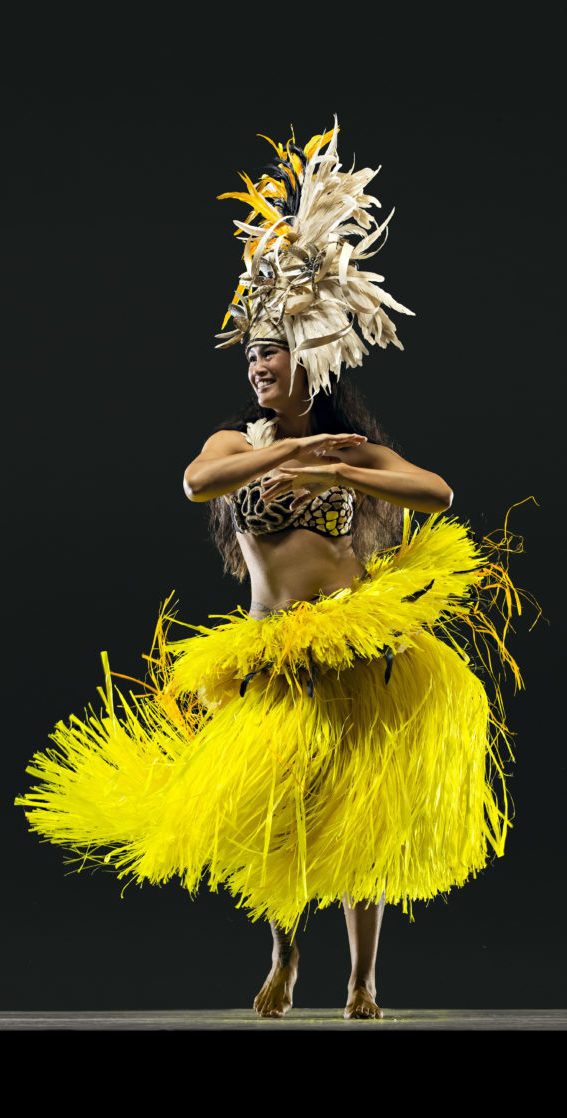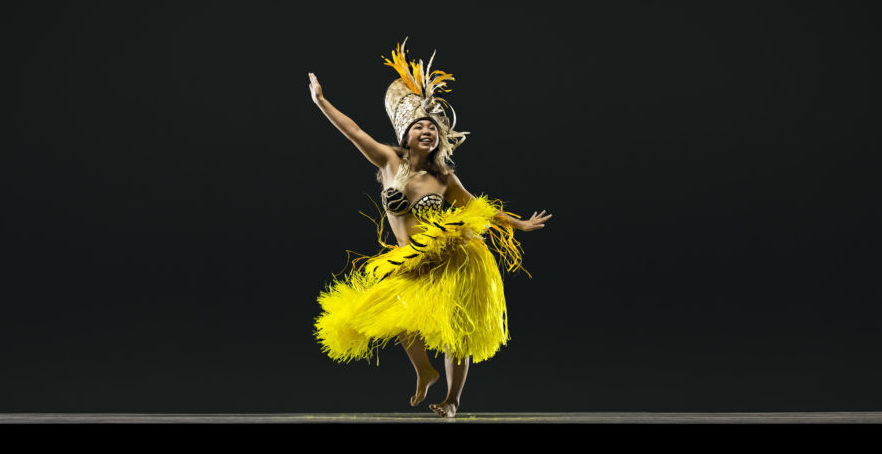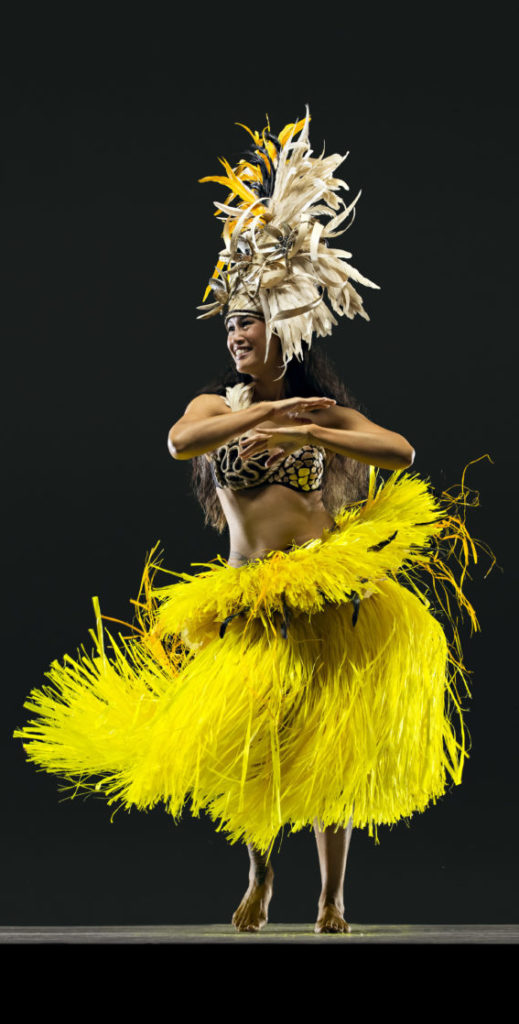

Lisa Aguilar is the Ra’atira Pupu (Director) and Choreographer for the East Bay-based Tahitian Dance Company, Te Mana O Te Ra. I spent a Sunday afternoon speaking with Lisa about her life and her dance, in a bustling coffee shop in downtown Walnut Creek. Although she had just led her company in two performances the day before at the Lesher Center for Arts, and was clearly exhausted (when the company performs, Lisa is usually dancing on stage with them), she radiated elation and pride for the performance her company had done the day before, and in anticipation for the upcoming piece that will premiere this July for the San Francisco Ethnic Dance Festival.
Lisa is working with her third generation of dancers, continuing to embody the beauty of Tahitian dance forms as she has for nearly 40 years, 20 of those with Te Mana O Te Ra. With her husband Rey, who serves the company as its Musical Director, Te Mana O Te Ra has become one of the most well-regarded and powerful Bay Area dance companies sustaining ‘ote’a—the Tahitian dance noted for its quick, rhythmic hip movement that is maintained throughout a series of group formations and additional choreography.

This July’s performance will be Te Mana O Te Ra’s eighth appearance in the Ethnic Dance Festival. Lisa credits the Festival with being a stepping stone to help educate people about many different dance genres, including Tahitian Dance, but this year she is using Tahitian tradition to provide a reflection of our current world—and response to it—back to the audience. Te Tiaturira’a – Believe, the piece they will perform on weekend two of the Festival, is based in Tahitian tradition but born from a very contemporary dismay that overtook Lisa as she processed the events of 2016. She explains:
“I was really pissed, had a lot of anger. I couldn’t really point out why. There was a lot of senseless violence in the world, and you turned on the news it was so ugly, with the Election, with ISIS… And I knew lots of people who were barely making it, living paycheck-to-paycheck and were struggling to pay their mortgage. Lots of people were depressed. I have a dance company with 100 plus people and I saw people there who were struggling, too. They would come to dance class to get out of what was going on their lives. Not to stop the sadness, but to just make it better for a little while.”
As she reflected on the collective pain, Lisa considered the many challenges she has faced. “I realized that the strength to overcome these challenges was within me, and the name of the piece—Believe—is meant to represent that. If we believe in ourselves as individuals, if we believe in ourselves as a group, if we believe in ourselves as a country we can overcome these challenges.”
When it was time to consider auditioning for the Ethnic Dance Festival, she decided to create a dance performance that acknowledged the difficulties in the world, while still providing audiences a sense of hope and light. Seeking light is critical, as Lisa explains, “We live in a pretty shitty world right now, but if we keep wallowing in how bad it is, we are not doing anything to help make it better.” It seems a bit of an obvious reminder, but we live in times where it’s so much easier to scream alone in darkness than dance together in light. Reminders are needed.
Lisa was also inspired by one of many Tahitian precedents for this kind of statement. She tells me that, “In the 50s and 60s, as nuclear weapons were being tested close to their home, Tahitians made dance and music that protested the tests. They used their art to make a statement, and that’s what I’m doing in my piece for the Ethnic Dance Festival.”
The piece will begin in sadness and dismay, before transitioning to a faster pace. The key color in her piece are natural shades of yellow, “which are meant to represent hope and the light within you, the strength that—if you remember to use it—can get you through anything. You will survive,” she states before laughing and completing the thought with “well, I hope we’ll survive.”
How Lisa came to practice ‘ote’a was a surprise to me. Born and raised in Oakland, Lisa is of Filipina/o descent and grew up learning dance forms from that culture. In the 1970s, she began taking Polynesian dance classes from Marge Bronson. Marge was a Navy wife who had studied different Polynesian dances while joining her husband on his Pacific postings during the 40s and 50s. The couple settled in Walnut Creek, where Marge taught at a community center and formed a company called “Dances of the Pacific.” “She taught all the Islands’ [dance forms] together,” Lisa explains, “back in the day we did everything.”
In the 70’s the Bay Area dance community was opening up to exploring culturally-specific dance forms from around the world (the San Francisco Ethnic Dance Festival, which began in 1978, was a product of this global expansion), but sometimes with little adherence to the concept of specificity. In 1979, Lisa made her first visit to Tahiti where she realized “people didn’t really know about Tahiti. Everybody connected [all Polynesian dances] to the standard Luau—you’d see Maori and Tahitian and Hawaiian,” all mixed and matched together.
In 1981 she began teaching her first Tahitian classes, and has traveled to Tahiti every year to work with her mentors there. After Marge Bronson passed away, Lisa and Rick Smith, another of Marge’s students formed a new company called “Drums of Polynesia.” Lisa taught Tahitian and he taught Hawaiian. “I was fine being part of a dance company that did Tahitian and Hawaiian,” Lisa says, and the trend towards specificity continued. “By the late 80s, early 90s, people who were doing these combined dance companies were splitting up to focus on specific cultures,” and Rick really wanted to focus on Hula. “I didn’t really plan on directing a company all by myself, but he said ‘you’ve been teaching Tahitian all along, what are you afraid of?’ He must [have] known something I didn’t, because we’ve both been very successful. (Rick Smith’s Halau is named Na Mamo No’eau). In 1997, Te Mana O Te Ra was started, and they performed in the Ethnic Dance Festival the following year.
Lisa and Rey teach Tahitian Dance and Drumming through the Walnut Creek Parks and Recreation department, and Lisa remains true to the mission of creating inroads for cultural diversity in a civic space. “Initially we are a parks and recreation group,” she insists. A noble cause to be certain, but by the time students are invited to dance with the performing group a different level of skill has been attained.
The company has toured Europe four times at the invitation of the European Folk Association, recently receiving a fourth invitation to dance in Tahiti in 2018 (a huge honor for a mainland company), and have continued to perform regularly throughout the Bay Area at large-scale, professional venues for full audiences. Pushed on this, Lisa tells me, “okay honey, I guess it feels like this old lady’s done pretty good. As far as the dance company goes, as long as I’m inhaling and exhaling I plan to continue permeating the culture and teaching dance.”
As with any cultural dance form, the movement and the music are part of a more complex cultural transmission. “I teach my dancers about the cultural and the history of Tahiti, so they understand what they are doing and what the movement means. I want to educate as many people as possible about this genre.” The task of running a 100+ member dance company is made no easier by the fact that in order to set choreography, she still “needs to get to know each of my dancers individually. No two dancers’ dance are alike, and not all of them are at the same place—either in their lives, or in their dancing.” She continues: “Some are quick, some not as quick, but if I see the desire in their heart, I’ll work harder with that kind of person, I think they need that kind of nurturing. If you encourage somebody, and they feel encouraged they try harder. You’ll end up with a quality dancer.”
Te Mana O Te Ra means energy of the sun. For Lisa that means “as long as I walk this earth, I hope the spirit is spread, and keeps spreading. I am the luckiest dance teacher. To make people really feel like they’re something else.” She adds, “If we made you smile, you can go out into the world and share that smile.”


